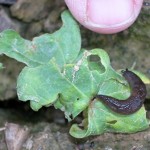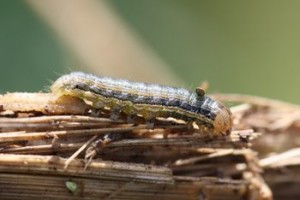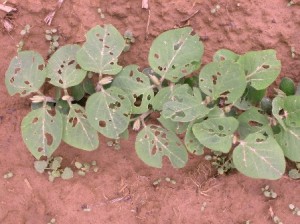 Slugs. There have been a few calls about slug feeding in corn, and I would expect some similar calls in other crops as they emerge. Slugs, unlike snails, lack shells and commonly feed on plants. They feed on leaves and sometimes cut the stems of cotton or soybean seedlings similar to cutworms. Snails rarely cause economic damage to field crops, and the ones typically encountered do not even feed on the plants. There are no set thresholds for slugs. The standard recommendation is to treat when stands are being reduced below acceptable levels. This requires some professional judgment. Below are a few bullets for your consideration.
Slugs. There have been a few calls about slug feeding in corn, and I would expect some similar calls in other crops as they emerge. Slugs, unlike snails, lack shells and commonly feed on plants. They feed on leaves and sometimes cut the stems of cotton or soybean seedlings similar to cutworms. Snails rarely cause economic damage to field crops, and the ones typically encountered do not even feed on the plants. There are no set thresholds for slugs. The standard recommendation is to treat when stands are being reduced below acceptable levels. This requires some professional judgment. Below are a few bullets for your consideration.
- The brown marsh slug is common in Tennessee. It grows to about a length of ½-inch (pictured above).
- Slugs are almost exclusively a pest in reduced-tillage fields and are much more problematic where there is a lot of plant residue on the soil surface. Thus, it is common to see them following corn, sorghum or behind cover-crop wheat.
- Slugs feed mostly at night. A common symptom is mysterious holes in the leaves or on the leaf margins. Look under plant debris, in soil crevices and other hidden locations if you suspect slugs are present.
- Warm and dry conditions go a long way in helping plants outgrow slug injury. Thus, expect the worst problems in wet fields and when plants are growing slowly.
- The worst problems I’ve encountered are when the seed furrow does not close completely. This typically occurs when the field is planted a little too wet. This creates a highway for slugs down the seed trench and allows themto feed on the plant below the ground level and during the day.
- In high residue fields, set your row cleaners to throw most the residue off the row. Some research has indicated this can reduce slug damage as much as 40%.
- No insecticides provide meaningful control of slugs.
- The only reliable control for established slug infestations is use of granular baits containing metaldehyde. Deadline M-Ps, from AMVAC, is the most commonly used product (link to label). The standard use rate is 10 lb of Deadline M-Ps per acre. Thus, it requires some forethought and effort to spread the bait evenly at such low rates. You can use higher rates, but the product is relatively expensive. Also, be advised that this product will probably not be in stock at your local distributor. It is necessary to find potential problems quickly so you have time to react.
Armyworms in Corn. Yes, this is the same armyworm that attacks wheat (often referred to as the true armyworm). Although there have been few calls in Tennessee about armyworms in wheat, I’ve received some calls from the Bootheel of Missouri and reports from surrounding states. I’ve also know of armyworm problems in corn from these same areas.

It is not uncommon for the true armyworm to feed on corn. This often happens adjacent to infested wheat fields or grassy areas. As their name implies, the armyworms will sometime move in numbers from wheat fields into corn. Feeding in corn will typically be worst along field edges. True armyworms will rarely if ever cause economic damage to cotton or soybean. They will feed on leaves and sometime totally defoliate the above-ground parts of corn plants. Injury may resemble cutworm or slug feeding, and like both pests, they tend to hide underground or under debris during the day. The good news is that true armyworms are pretty easy to control with relatively low rates of synthetic pyrethroid insecticides. Often, treatment around field edges is all that is needed. Like with slugs, I can’t give you an exact threshold. Treatment is suggested if corn stands are being reduced below acceptable levels. Keep in mind that the growing point of corn is below ground until plants are at the 3rd or 4th leaf stage. Even severely defoliated plants often recover if the growing point of the plant is not destroyed.



One thought on “Slugs in Corn and Other Crops; Armyworms in Corn”
Comments are closed.